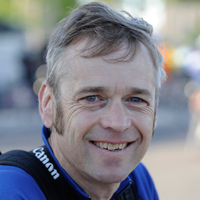Hall of Famer Hank Aaron, a Milwaukee hero and national icon, was overshadowed during a visit to the Menomonee Valley by expansive mounds of dirt and dozens of children with shovels.
The dark piles extending east from 37th Street along the Menomonee River represented the start of a reclamation project pursued for more than a decade by public officials, non-profit educators and outdoor enthusiasts. In a year, they will sprout the first seedlings of a 24-acre urban park and an extension of the Hank Aaron State Trail on the north side of the river.
Sculpted to recreate kettles, moraines and eskers, the mounds will bring the ecology and glacial topography of southern Wisconsin to an urban environment and an outdoor science laboratory to area children.
"When I saw those mounds, it almost brought tears to my eyes," said Ken Leinbach, executive director of the Urban Ecology Center. "I never thought that dirt would have that effect on me."
At a ground-breaking for the project on Thursday, Leinbach juggled baseballs to entertain the crowd as it waited for Hammerin' Hank, and to demonstrate how a single idea can become a reality when you add more people (or balls) to the cause.
More than a dozen foundations and individuals have donated $100,000 or more to Menomonee Valley from the Ground Up, and roughly $11 million in federal grants have been allocated to the trail extension and park. The total project will cost roughly $26 million and roughly $22.4 million has been raised to date.
Menomonee Valley Partners, the Urban Ecology Center, the City of Milwaukee and the Wisconsin Department of Natural Resources have been the principals in the long effort to bring the park from idea to project.
The group effort continued with a gracious Aaron joining the children and shoveling gravel onto an extension of the bike path that carries his name.
"This is wonderful," Aaron said. "I've tried to do everything I could to show young people the right direction to travel. To see children ready to dig makes me feel so proud."
Those children will be the true beneficiaries of the work being done to transform an abandoned railroad switching yard into a piece of nature in the industrial corridor.
The park will have one mile of accessible hiking trails, river access for fishing and canoeing, community gardens and two bridges to connect the green space with the Mitchell Park Domes and the Clarke Square neighborhood.
The Urban Ecology Center will open a third branch at 3700 W. Pierce St. and use the park space as an outdoor science classroom, in an area with high levels of poverty and low levels of science proficiency.
Miriam Miranda, a teacher and social worker at the nearby St. Rafael School, shared Leinbach's emotion as she described the importance of the educational opportunity the park will offer.
Children from throughout the city will see, touch, smell and hear the plants and wildlife many have only explored through pictures and words in their textbooks, she said. They will be able to hike, snowshoe and paddle in the new natural space.
"They've heard about these things, but not many have had these things accessible to them," Miranda said.
Omar Bonilla-Ortiz, a visitor services representative for the UEC, expanded on that idea in describing his exploits in the valley as a child. Then, he and his friends climbed fences, fought through thick brush and dodged the police to explore beyond the confines of their neighborhood.
The park will make the world a bigger place for the children like him, Bonilla-Ortiz said.
Like Bonilla-Ortiz, author Eddee Daniels explored the Menomonee Valley when it was a deteriorated industrial corridor. Weeds and pollution choked the natural plant life, and the area was more frightening than inviting.
"If fear keeps you from nature, no one is going to appreciate it," Daniels said. "This park allows people in the community to have access to nature they haven't had in years, or in lifetimes. We've created a park that will be as vital as any natural area."
The park, yet to be named, is scheduled to open in 2013. The land will be owned by the City of Milwaukee and managed by the Wisconsin Department of Natural Resources.
Memories of running cross-country for the Slinger Owls motivated Tom Held to get his body moving again when he turned 30. Almost two decades later, he's still on the move. The 49-year-old bikes, runs and skis, and covers news for similarly active people as a freelance writer and blogger.
He spent 26 years as a daily news reporter, and applies that experience to dig out stories about athletes, races, endurance sports, fitness and self-propelled transportation. His work has appeared in Silent Sports Magazine, Wisconsin Trails and Cross-Country Skier.
Held lives in the Bay View neighborhood, where he counts being Dad to twin daughters part of his daily workout.







